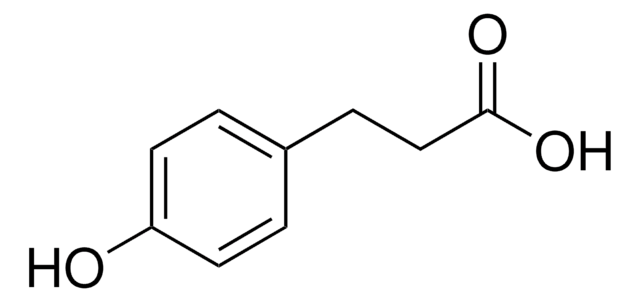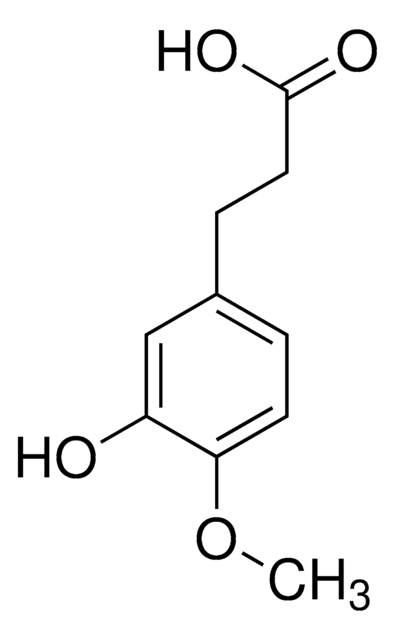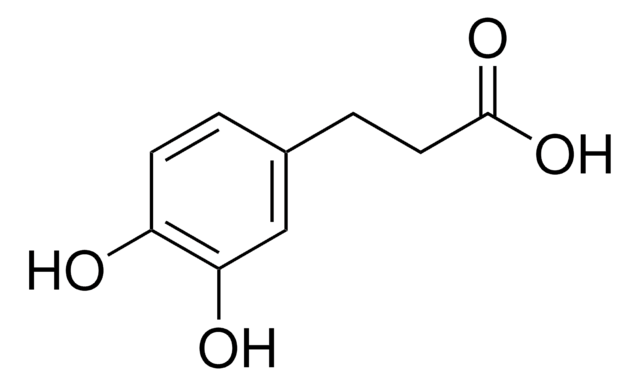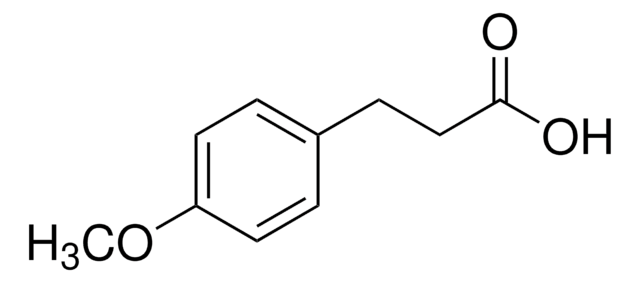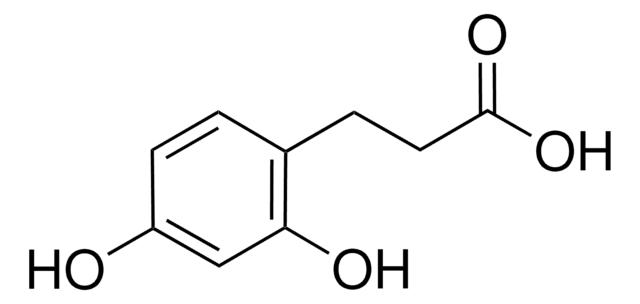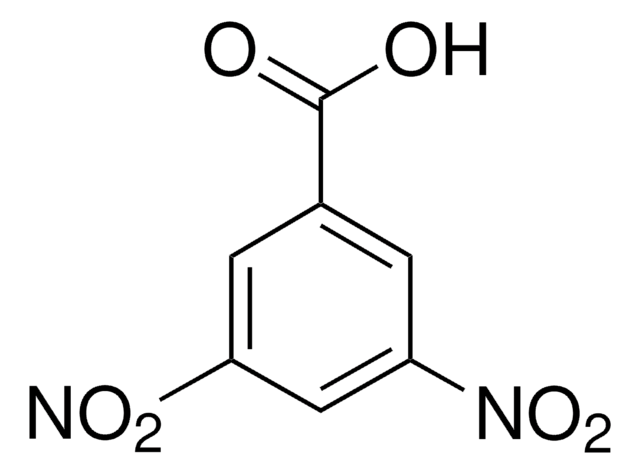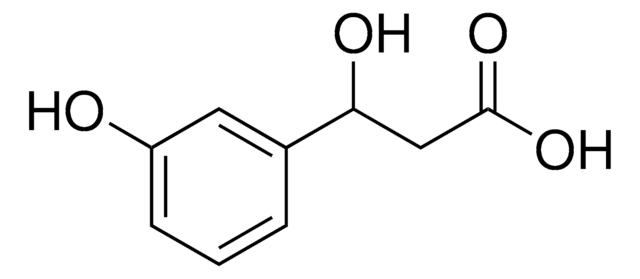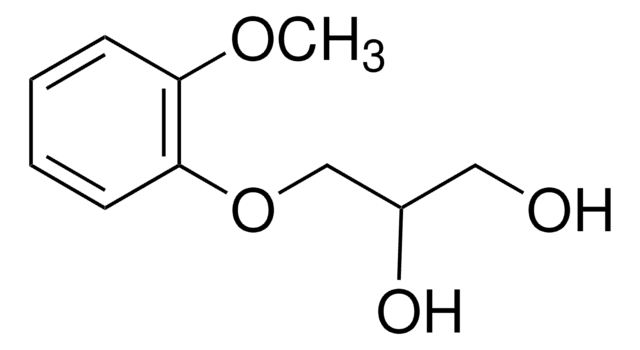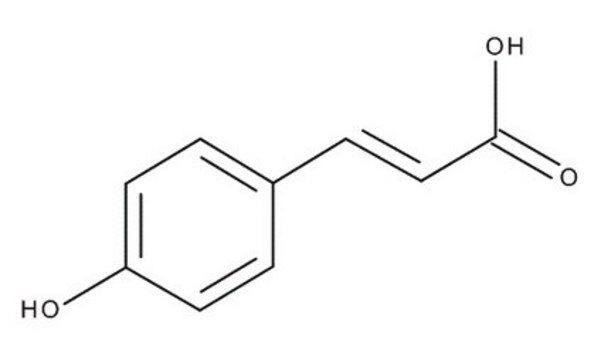17803
3-(4-Hydroxy-3-methoxyphenyl)propionic acid
≥96.0% (T)
Sinónimos:
Hydroferulic acid
Iniciar sesiónpara Ver la Fijación de precios por contrato y de la organización
About This Item
Fórmula empírica (notación de Hill):
C10H12O4
Número de CAS:
Peso molecular:
196.20
Beilstein:
2110370
Número CE:
Número MDL:
Código UNSPSC:
12352100
ID de la sustancia en PubChem:
NACRES:
NA.22
Productos recomendados
Nivel de calidad
Ensayo
≥96.0% (T)
Formulario
powder
mp
87-93 °C
grupo funcional
carboxylic acid
cadena SMILES
COc1cc(CCC(O)=O)ccc1O
InChI
1S/C10H12O4/c1-14-9-6-7(2-4-8(9)11)3-5-10(12)13/h2,4,6,11H,3,5H2,1H3,(H,12,13)
Clave InChI
BOLQJTPHPSDZHR-UHFFFAOYSA-N
Categorías relacionadas
Aplicación
3-(4-Hydroxy-3-methoxyphenyl)propionic acid (hydroferulic acid) was used to inhibit prostaglandin E(2) production.
Palabra de señalización
Warning
Frases de peligro
Consejos de prudencia
Clasificaciones de peligro
Acute Tox. 4 Oral - Eye Irrit. 2 - Skin Irrit. 2 - STOT SE 3
Órganos de actuación
Respiratory system
Código de clase de almacenamiento
11 - Combustible Solids
Clase de riesgo para el agua (WGK)
WGK 2
Punto de inflamabilidad (°F)
Not applicable
Punto de inflamabilidad (°C)
Not applicable
Equipo de protección personal
dust mask type N95 (US), Eyeshields, Gloves
Elija entre una de las versiones más recientes:
¿Ya tiene este producto?
Encuentre la documentación para los productos que ha comprado recientemente en la Biblioteca de documentos.
Los clientes también vieron
Mar Larrosa et al.
Molecular nutrition & food research, 53(8), 1044-1054 (2009-06-27)
The polyphenols in fruits and vegetables may be partly responsible for the health-promoting effects attributed to fruit and vegetable intake. Although their properties have been relatively well studied, the activity of their metabolites, produced after ingestion, has been poorly investigated.
Oscar J Lara-Guzmán et al.
Free radical biology & medicine, 160, 604-617 (2020-08-04)
Oxylipins are considered biomarkers related to cardiovascular diseases (CVDs). They are generated in vivo via the oxygenation of polyunsaturated fatty acids as a result of oxidative stress and inflammation. Oxylipins are involved in vascular functions and are produced during foam
Lee E Hunt et al.
Biomolecules, 11(1) (2021-01-06)
There is ongoing interest in exploiting the antioxidant activity and other medicinal properties of natural monophenolic/polyphenolic compounds, but their generally low aqueous solubility limits their applications. Numerous studies have been undertaken to solubilize such compounds via supramolecular derivatization with co-crystal
Elzbieta Radzyminska-Lenarcik et al.
Polymers, 11(11) (2019-11-02)
The study involved the transport of zinc(II), cadmium(II), and nickel(II) ions from acidic aqueous solutions using polymer inclusion membranes (PIMs). PIMs consisted of cellulose triacetate (CTA) as a support; o-nitrophenyl pentyl ether (o-NPPE) as a plasticizer; and 1-octylimidazole (1), 1-octyl-2-methylimidazole
Miren Gómez-Juaristi et al.
Nutrients, 11(7) (2019-06-30)
Cocoa has beneficial health effects partly due to its high flavanol content. This study was aimed at assessing the absorption and metabolism of polyphenols in two soluble cocoa products: a conventional (CC) and a flavanol-rich product (CC-PP). A crossover, randomized
Nuestro equipo de científicos tiene experiencia en todas las áreas de investigación: Ciencias de la vida, Ciencia de los materiales, Síntesis química, Cromatografía, Analítica y muchas otras.
Póngase en contacto con el Servicio técnico